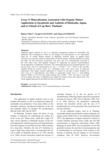Gross N Mineralization Associated with Organic Matter Application to Inceptisols and Andisols of Hokkaido, Japan, and to Ultisols of Lop Buri, Thailand
Japan Agricultural Research Quarterly
| ISSN | 00213551 |
|---|---|
| NII recode ID (NCID) | AA0068709X |

Full text
jarq56-2_129-135.pdf421.83 KB
Applying organic material to soil is an important management method for sustainable crop production. We investigated its effect on soil nitrogen (N) mineralization in two experiments using the 15N isotope dilution method. In Hokkaido, Northern Japan, we applied wheat (Triticum aestivum) straw to Brown Andosol (BA; US Soil Taxonomy: Andisols) and Brown Lowland soil (BLs; US Soil Taxonomy: Inceptisols). The gross rate of N mineralization increased in BA with wheat straw and adequate inorganic N, supporting the general recommendation for the application of additional N fertilizer. The relationship between the microbial biomass N (x) and the gross rate of N mineralization (y) was y = 0.234e0.0751x (R2 = 0.815) in BA and BLs sampled during the growth season of a subsequent maize (Zea mays) crop. In long-term experiments with organic material application to Ultisols in Lop Buri, Central Thailand, the gross rates of N mineralization were higher in organically treated soil at a water-holding capacity (WHC) of 27%-41% and similar among soils at WHC ≈ 20%. The rates in Lop Buri soil were higher than those in Hokkaido soils, despite the former’s lower total carbon levels. The results suggest high specific microbial activities in Lop Buri soil.
| Date of issued | |
|---|---|
| Creator | Rikiya NIRA Prapit SANGTONG Takao FUJIMOTO |
| Subject | maize 15N soil microbial biomass soil moisture |
| Publisher | Japan International Research Center for Agricultural Sciences |
| Received Date | 2020-11-26 |
| Accepted Date | 2021-06-25 |
| Available Online | |
| Volume | 56 |
| Issue | 2 |
| spage | 129 |
| epage | 135 |
| DOI | 10.6090/jarq.56.129 |
| Language | eng |
